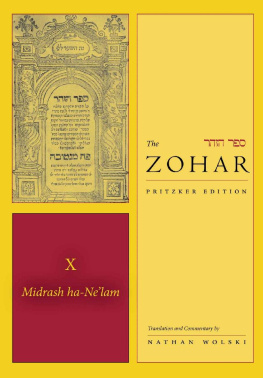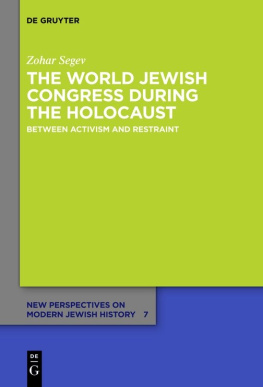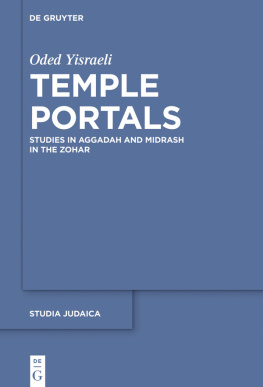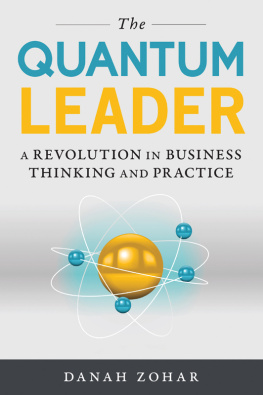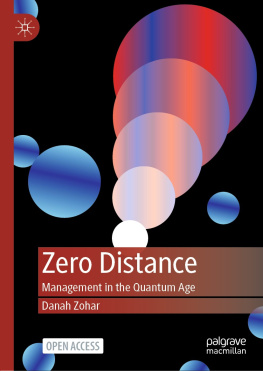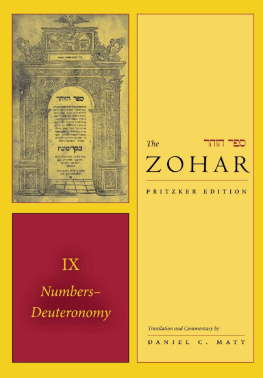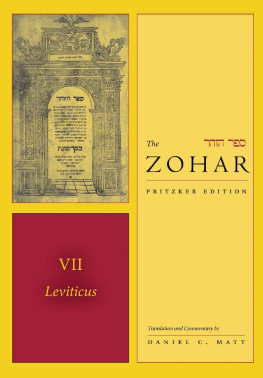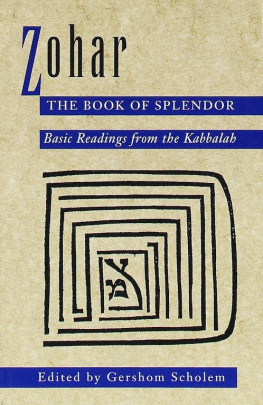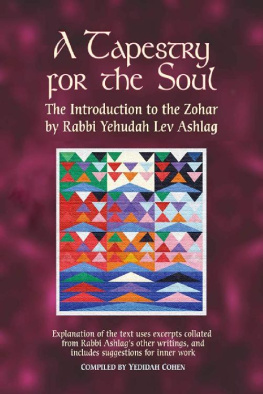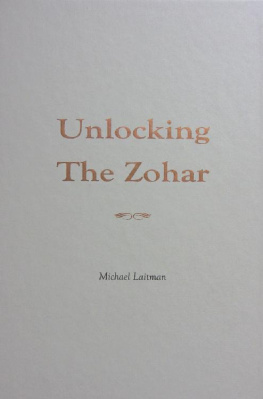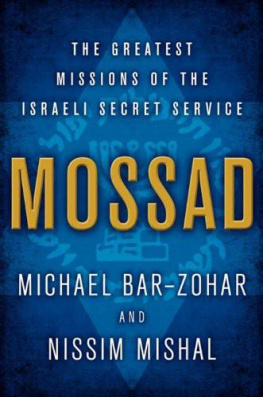Nathan Wolski - The Zohar (Zohar: The Pritzker Editions) Vol 10: Midrash ha-Nelam
Here you can read online Nathan Wolski - The Zohar (Zohar: The Pritzker Editions) Vol 10: Midrash ha-Nelam full text of the book (entire story) in english for free. Download pdf and epub, get meaning, cover and reviews about this ebook. year: 2019, publisher: Stanford University Press, genre: Science. Description of the work, (preface) as well as reviews are available. Best literature library LitArk.com created for fans of good reading and offers a wide selection of genres:
Romance novel
Science fiction
Adventure
Detective
Science
History
Home and family
Prose
Art
Politics
Computer
Non-fiction
Religion
Business
Children
Humor
Choose a favorite category and find really read worthwhile books. Enjoy immersion in the world of imagination, feel the emotions of the characters or learn something new for yourself, make an fascinating discovery.
- Book:The Zohar (Zohar: The Pritzker Editions) Vol 10: Midrash ha-Nelam
- Author:
- Publisher:Stanford University Press
- Genre:
- Year:2019
- Rating:4 / 5
- Favourites:Add to favourites
- Your mark:
- 80
- 1
- 2
- 3
- 4
- 5
The Zohar (Zohar: The Pritzker Editions) Vol 10: Midrash ha-Nelam: summary, description and annotation
We offer to read an annotation, description, summary or preface (depends on what the author of the book "The Zohar (Zohar: The Pritzker Editions) Vol 10: Midrash ha-Nelam" wrote himself). If you haven't found the necessary information about the book — write in the comments, we will try to find it.
Nathan Wolski: author's other books
Who wrote The Zohar (Zohar: The Pritzker Editions) Vol 10: Midrash ha-Nelam? Find out the surname, the name of the author of the book and a list of all author's works by series.
The Zohar (Zohar: The Pritzker Editions) Vol 10: Midrash ha-Nelam — read online for free the complete book (whole text) full work
Below is the text of the book, divided by pages. System saving the place of the last page read, allows you to conveniently read the book "The Zohar (Zohar: The Pritzker Editions) Vol 10: Midrash ha-Nelam" online for free, without having to search again every time where you left off. Put a bookmark, and you can go to the page where you finished reading at any time.
Font size:
Interval:
Bookmark:

The translation and publication of the Zohar is made possible through the thoughtful and generous support of the Pritzker Family Philanthropic Fund.
Stanford University Press
Stanford, California
2016 by Zohar Education Project, Inc.
All rights reserved.
For further information, including the Aramaic text of the Zohar, please visit www.sup.org/zohar
Library of Congress Cataloging-in-Publication Data is available from the Library of Congress at http://Iccn.loc.gov/2003014884
ISBN 978-0-8047-8804-5 (cloth)-
ISBN 978-1-5036-0347-9 (electronic) (vol. 10)
Printed in the United States of America on acid-free, archival-quality paper.
Designed by Rob Ehle
Typeset by El Ot Pre Press & Computing Ltd., Tel Aviv,
in 10.5/14 Minion.
Academic Committee
for the Translation of the Zohar
Daniel Abrams
Bar-Ilan University
Joseph Dan
Hebrew University
Rachel Elior
Hebrew University
Asi Farber-Ginat
University of Haifa
Michael Fishbane
University of Chicago
Pinchas Giller
American Jewish University
Amos Goldreich
Tel Aviv University
Moshe Hallamish
Bar-Ilan University
Melila Hellner-Eshed
Hebrew University
Boaz Huss
Ben-Gurion University
Moshe Idel
Hebrew University
Esther Liebes
Gershom Scholem Collection, Jewish National and University Library
Yehuda Liebes
Hebrew University
Bernard McGinn
University of Chicago
Ronit Meroz
Tel Aviv University
Charles Mopsik,
Centre National de la Recherche Scientifique
Michal Oron
Tel Aviv University
Haviva Pedaya
Ben-Gurion University
Bracha Sack
Ben-Gurion University
Elliot R. Wolfson
New York University
Arthur Green
Co-Chair
Brandeis University
Rabbi Yehiel Poupko
Co-Chair
Jewish Federation of Chicago
Margot Pritzker
Chair, Zohar Education Project, Inc.
Daniel C. Matt
Translator, Zohar Education Project, Inc.
Contents
NATHAN WOLSKI |
MIDRASH HA-NELAM |
Parashat Be-Reshit |
Parashat Noa |
Parashat Lekh Lekha |
Parashat Va-Yera |
Parashat ayyei Sarah |
Parashat Toledot |
Parashat Va-Yetse |
Parashat Shemot |
Parashat Ki Tetse |

Midrash ha-Nelamthe Concealed Midrash, or perhaps better, the Midrash of the Concealedis recognized by all Zohar scholars as the earliest layer of the Zoharic literary corpus. Midrash ha-Nelam thus stands at the very origin of the Zoharic enterprise and presents the first fruits of the Zoharic world.
Midrash ha-Nelam on the Torah differs greatly from the main body of the Zohar. Sefirotic symbolism is virtually absent from the work (except for parts of parashat Shemot), as is the grand epic narrative featuring the Companions gathered around Rabbi Shimon son of Yoai. In their place, one finds philosophical allegory and proto-kabbalistic midrash, as well as homilies and narratives featuring a much larger number of rabbis, including elaborate stories about the Masters of Mishnahthe forerunner to the Zoharic fellowship. Though Midrash ha-Nelam is in some ways stylistically undeveloped in comparison to the main body of the Zohar, readers will have no difficulty in sensing the same daring exegetical spirit, the same Zoharic eye, running through its pages. Indeed, Midrash ha-Nelam might be regarded as the portrait of the artist as a young manbe that artist Moses de Len, or the Zohar as a wholerevealing the first stirrings of genius, the original literary breakthrough that lent the Zohar proper its distinctive landscape, tone, and rhythm.
Where the Zohar proper is concerned with theosophy, i.e., knowledge of the mysteries of the inner workings of divinity and its emanations, lavishly articulated through rich symbolism, Midrash ha-Nelam presents inter alia allegorical readings of the Torah and more conventional Neoplatonic philosophical teachings. Through the story of the patriarchs, these allegorical readings tell the grand story of the souls descent from the world above (Abraham signifying the soul and Sarah the body), its sojourns and adventures on earth (in particular battling Lot, the evil impulse), its peregrinations after death (Melchizedek, king of Salem signifying Michael the prince of Jerusalem Above; the King of Sodom signifying the prince of Hell), culminating in the resurrection (Isaac and Rebekah signifying the soul in the resurrected body) and the purification of the evil impulse in the next world (as Lot the accursed is replaced by Laban, the refined impulse.) Midrash ha-Nelam marks one of the high points, if not the high point, of medieval Jewish philosophical allegory.
Philosophical allegory, however, is only one element of Midrash ha-Nelam. The other is midrash, at times seemingly similar in spirit to classical rabbinic midrash, yet invariably infused with proto-kabbalistic themes. Creation, cosmology, the angelic realm, the origin and nature of the soul, and, of course, the drama of the people of Israel and their ritual and historical life all lie at the center of Midrash ha-Nelams concerns. And even if this proto-kabbalistic midrash does not contain the same mythic and erotic element found in the Zohar proper, some of the Zohars most important and characteristic innovations are first found here: the nocturnal delight in the Garden of Eden, as well as the Companions penchant for walking on the way and their concomitant quest to pursue the deeper meaning of Torah.
Significantly, these two aspects, the allegorical-philosophical and the proto-kabbalistic, align with another interesting feature of Midrash ha-Nelam: its bilingualism. Unlike the main body of the Zohar, which is written entirely in Aramaic, Midrash ha-Nelam combines Hebrew and Aramaic. Sometimes entire sections appear in one language, while on other occasions the language shifts mid-sentence. Interestingly, this linguistic fault-line corresponds, in the main, with the two chief modes of Midrash ha-Nelam, and so we find that the philosophical allegorical layer of the text is composed in Hebrew, and the proto-kabbalistic midrashic layer in Aramaic. Unfortunately, this crucial element of the texture of Midrash ha-Nelam is lost in translation, though I have noted significant fault-lines in the notes.
How are we to make sense of this arrangement? Is Midrash ha-Nelam a unified work? Or might the two languages point to two different compositions brought together by a later editor? And if two different compositions, which is earlier? Or might we assume a single author, who wrote one work in his youth, perhaps the philosophical layer, and appended and interlaced the proto-kabbalistic layer later in his life? Even more intriguing, can we imagine a single author moving between languages as he moved between genres and modes of discourse? Whatever the case (and part of the charm of reading
Next pageFont size:
Interval:
Bookmark:
Similar books «The Zohar (Zohar: The Pritzker Editions) Vol 10: Midrash ha-Nelam»
Look at similar books to The Zohar (Zohar: The Pritzker Editions) Vol 10: Midrash ha-Nelam. We have selected literature similar in name and meaning in the hope of providing readers with more options to find new, interesting, not yet read works.
Discussion, reviews of the book The Zohar (Zohar: The Pritzker Editions) Vol 10: Midrash ha-Nelam and just readers' own opinions. Leave your comments, write what you think about the work, its meaning or the main characters. Specify what exactly you liked and what you didn't like, and why you think so.

